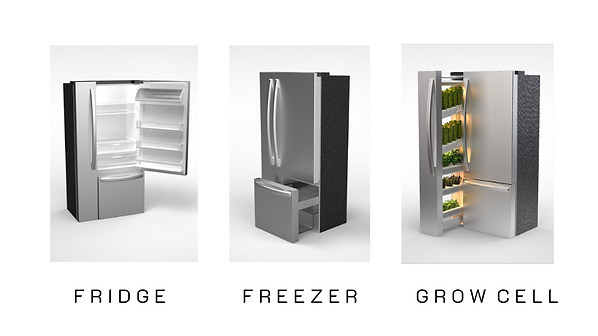Fable's Pitch at Creative Coast's
FastPitch Event
May 2022



Exactly three months ago, we placed first out of more than ninety teams at SCAD StartUp— our university’s week-long startup innovation competition. In that week, we discovered that by 2050, Earth’s population will reach 10 billion people. That means we need to increase food production by over 70%, yet at this moment in time, we only have 60 years of farmable soil left.
So, we created a product that will change how consumers think about their food sources. If we can’t look to conventional agriculture to increase food production, why not do it ourselves in our own homes?

After the compeition, the first step we took was backtracking to find the real problem, the real customer. We opened a conversation in our community, learning their pain points and narrowing our target market to middle-income households of 2-5 people. While they do care about the future of the planet, they have more urgent problems that need to be addressed first.
Middle-class households would like to eat more fresh fruits and vegetables because they want their families to eat the best food possible. But, there are barriers in the way. Fresh produce is expensive, especially when it’s organic, and if it’s not organic, they worry about the preservatives and pesticides they are feeding their children. Unfortunately, they don’t have the time or energy to garden at home. We’d found a niche we could cater to: providing access to fresh fruits and vegetables while saving our customers money and time.


Then, we looked toward the food industry. We found that the 20th century was riddled with mass-marketed food trends such as TV Dinners, farms becoming factories, and the invasion of high fructose corn syrup. However, at the turn of the century, food trends became centered around healthy eating: superfoods, veganism, the revival of farmers markets. Clearly, people are starting to care about where their food comes from, so why isn’t home gardening more popular?



When we looked at our competitors, we found a gap in the market. There isn’t an affordable appliance for growing food that is also space-conscious enough to fit comfortably in the average home. Current systems are either open air— which means they are prone to pests and not climate-controlled, therefore requiring more work— or they take up an obscene amount of space and are too expensive. The average consumer doesn’t have the time, space, or money for these systems.
That’s why our product, the Fable Refrigerator, is an all-in-one fridge, freezer, and farm appliance that, despite its extra compartment, is still the same size as the average refrigerator: 36 inches wide. That extra compartment, called the Grow Cell, is a tall pull-out drawer housing a vertical hydroponic farm. It’s climate-controlled and almost entirely self-sustaining, meaning users can grow a variety of fresh, nutritious produce, regardless of season or location and without the time and effort spent on traditional gardening. The Grow Cell replaces the need to buy produce that can be grown hydroponically such as lettuce, microgreens, herbs, tomatoes, berries, and so much more.


The hydroponic system uses a nutrient film technique for lightweight crops and a wick system for heavyweight crops. It is also directly connected with the fridge, utilizing the fridge’s air circulation systems and water and electrical hook ups. Hydroponics, for those of you who aren’t familiar with it, is a method of farming that doesn’t require soil. And because there’s no soil, there is no risk for soil diseases nor a need for pesticides or weedkillers. There’s also no water waste or runoff pollution and plants grow faster in hydroponic systems because their needs are perfectly met.

Fable also offers supplemental subscriptions. Every three months, customers must replace the nutrient filter that adds nutrients to the water in the hydroponic system. The Fable Refrigerator can be customized to fit each user’s unique dietary needs as well. When they want to change what kind of plants they are growing in their fridge, users can order plant tray replacements. The plant trays inside the Grow Cell are also rearrangeable, making the crop yield completely personalized to the user.

You may be thinking, what’s it going to cost? At market, the Fable Refrigerator is going to cost $3000. When we surveyed our target market, we found that they spend an average of $46 per week on fresh fruits and vegetables, or $2,392 per year. Let’s assume that Fable users will still spend $700 on large fruits and root vegetables that cannot be grown hydroponically. That means, after you factor in $60 per year for nutrient refills and $144 for water and electricity, Fable still pays for itself in three years. Instead of paying $5,076, users will spend $3,612. After five years, instead of paying $8,460, users will spend $4,020. And after 10 years? Instead of $16,920, user will spend only $5,040.


In the last three months, we’ve launched our website, built a low fidelity prototype, met with business and industry professionals, and participated in a business incubator. We’ve come a long way, but we still have an even longer, tougher journey ahead of us. Our current goal is to acquire funding for further development so that we can create a high-fidelity prototype for user testing, conduct further research to streamline our technology, and add more talent to our team.

We are dedicated to normalizing farming at home and indoors by offering an affordable, space-conscious appliance that gives any household the ability to grow a variety of nutrient-rich and truly organic produce, regardless of season or location. And hopefully, by 2050, we’ve revolutionized the agricultural industry by giving every human on earth the agency to grow their own food knowledgeably and sustainably.
Shortening the distance from farm to table, Fable.